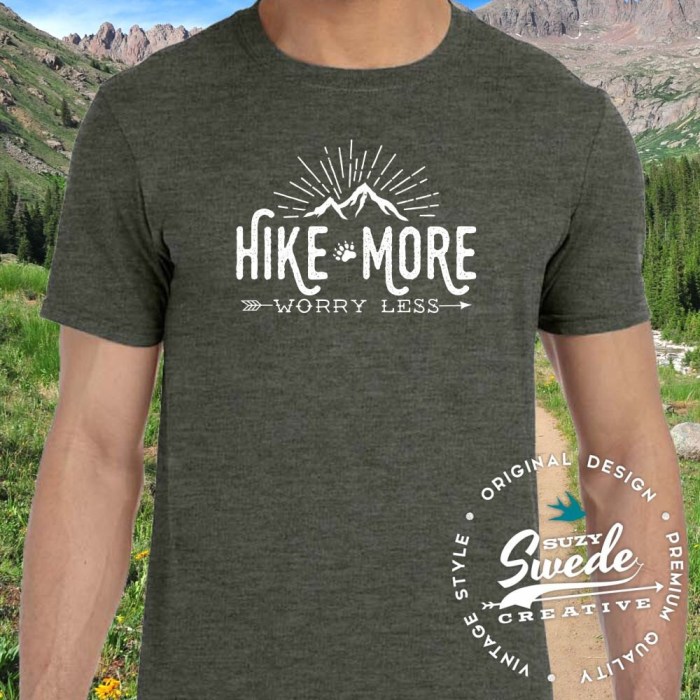Hiking Tops: Conquer any trail in comfort and style. Choosing the right hiking top is crucial for a successful and enjoyable outdoor adventure. From lightweight, breathable options for scorching summer hikes to insulated, windproof layers for tackling winter’s chill, the world of hiking apparel offers a diverse range of materials, features, and styles. This comprehensive guide will help you navigate the options, ensuring you’re prepared for any weather condition and activity level.
We’ll delve into the specifics of fabrics like merino wool, polyester, and cotton blends, exploring their unique properties and suitability for different climates. Learn how moisture-wicking technology, UPF sun protection, and strategic zipper placement can significantly enhance your hiking experience. Discover the importance of proper fit and sizing, and how layering can adapt your outfit to changing conditions.
This guide isn’t just about picking a shirt; it’s about optimizing your performance and comfort on the trail.
Types of Hiking Tops
Choosing the right hiking top can significantly impact your comfort and performance on the trail. The ideal top will depend on factors like weather conditions, the intensity of your hike, and personal preferences. Understanding the different materials and styles available is key to making an informed decision that optimizes your outdoor experience.
Hiking Top Materials
The material of your hiking top plays a crucial role in regulating your body temperature and managing moisture. Different fabrics offer varying levels of breathability, warmth, and durability, making some better suited for specific climates and activities.
- Merino Wool: Known for its exceptional breathability, odor resistance, and natural warmth, merino wool is a fantastic choice for a wide range of conditions. It excels in regulating temperature, keeping you warm when it’s cold and cool when it’s warm. However, it can be more expensive than synthetic options and dries slower.
- Polyester: A popular synthetic material, polyester is highly durable, dries quickly, and offers excellent moisture-wicking properties. It’s a cost-effective option that performs well in various weather conditions, making it a versatile choice for many hikers. However, it might not be as breathable as merino wool and can retain odor over time.
- Cotton Blends: Cotton blends often incorporate polyester or other synthetic fibers to improve moisture-wicking and drying time. Cotton itself is soft and comfortable but absorbs moisture readily, which can lead to discomfort and chilling if it gets wet. Cotton blends offer a balance between comfort and performance, but they may not be ideal for strenuous hikes in humid or wet conditions.
Hiking Top Styles
The style of your hiking top also impacts comfort and performance. Choosing the right sleeve length and overall fit is essential for optimizing your experience.
| Style | Material Advantages | Material Disadvantages | Best Weather Conditions |
|---|---|---|---|
| Short-Sleeve | Increased ventilation, lightweight, enhanced freedom of movement | Less sun protection, potential for sunburn, less warmth in cooler temperatures | Warm and sunny conditions |
| Long-Sleeve | Superior sun protection, warmth in cooler temperatures, added protection from insects and brush | Reduced ventilation, can feel warmer in hot weather, potential for overheating | Moderate to cool temperatures, sunny conditions, or insect-prone areas |
| Tank Top | Maximum ventilation, lightweight, ideal for layering | Minimal sun protection, less warmth, not suitable for cooler temperatures or insect-prone areas | Hot and sunny conditions, ideal as a base layer |
Performance-Enhancing Design Features
Many hiking tops incorporate design features to enhance performance and comfort. These features work together to regulate body temperature, manage moisture, and provide protection from the elements.
- Moisture-Wicking: Moisture-wicking fabrics draw sweat away from your skin, keeping you dry and comfortable. This is crucial for preventing chilling and maintaining optimal body temperature during strenuous activity.
- Ventilation: Mesh panels or strategically placed vents provide increased airflow, allowing for better heat regulation and preventing overheating. This is particularly beneficial during intense hikes in warm conditions.
- Sun Protection: Features like UPF (Ultraviolet Protection Factor) ratings indicate the level of sun protection offered by the fabric. A higher UPF rating provides better protection against harmful UV rays.
Care and Maintenance of Hiking Tops

Proper care and maintenance are crucial for extending the life and performance of your hiking tops. Neglecting these aspects can lead to premature wear, fading, and ultimately, a need for frequent replacements. By following a few simple steps, you can significantly improve the longevity of your favorite hiking gear and save money in the long run. This involves understanding the best washing and drying techniques, appropriate storage methods, and how to tackle common problems like fading and abrasion.
Washing and Drying Hiking Tops
Maintaining the performance and longevity of your hiking tops requires a meticulous approach to washing and drying. Improper techniques can damage the fabric, leading to shrinking, fading, or weakening of the material. Following these steps will help preserve the quality and functionality of your gear.
- Pre-treat stains: Before washing, address any visible stains by gently rubbing a small amount of stain remover directly onto the affected area. Allow it to sit for a few minutes before proceeding.
- Wash in cold water: Always wash your hiking tops in cold water using a gentle cycle. Hot water can cause shrinkage and damage the fabric’s fibers, especially in synthetic materials like polyester and nylon.
- Use a mild detergent: Opt for a mild detergent specifically designed for outdoor clothing or a gentle, fragrance-free laundry detergent. Harsh chemicals can strip the fabric of its water-resistant properties.
- Avoid fabric softener: Fabric softener can reduce the wicking capabilities of your hiking tops, making them less effective at drawing moisture away from your skin. This can lead to discomfort and potential chafing.
- Air dry whenever possible: Air drying is the best method for preserving the integrity of your hiking tops. Hang them on a clothesline or a drying rack away from direct sunlight to prevent fading. Avoid using a clothes dryer unless absolutely necessary.
- Machine drying (if necessary): If you must use a machine dryer, select the lowest heat setting and remove the garment immediately after the cycle completes to prevent wrinkles and potential damage.
Storing Hiking Tops
Proper storage is essential to prevent damage and maintain the quality of your hiking tops. Improper storage can lead to wrinkles, musty odors, and even attract pests.Storing your hiking tops in a cool, dry place, away from direct sunlight, is crucial. Avoid storing them in damp areas or plastic bags, as this can trap moisture and encourage mildew growth.
Consider using breathable storage bags or shelves. Folding your tops neatly rather than crumpling them helps to maintain their shape and prevent wrinkles. For long-term storage, consider using cedar chests or sachets to deter insects.
Addressing Common Issues
Knowing how to identify and address common issues with hiking tops can save you money and extend their lifespan.
- Fading: Sunlight is the primary culprit behind fading. To minimize fading, always air dry your tops in the shade. Avoid leaving them in direct sunlight for extended periods. Washing in cold water and using a mild detergent can also help prevent fading.
- Shrinking: Shrinking is usually caused by washing in hot water or using a high heat setting in the dryer. Always follow the washing instructions on the care label and air dry whenever possible to avoid shrinking.
- Abrasion Damage: Abrasion damage, such as snags or tears, can occur from contact with rough surfaces during hikes. Regularly inspect your hiking tops for any signs of wear and tear. Small snags can be carefully trimmed with sharp scissors to prevent them from becoming larger tears.
Hiking Top Illustrations

Choosing the right hiking top significantly impacts your comfort and performance on the trail. The ideal top depends heavily on the climate and intensity of your hike. Let’s explore three distinct examples, each designed for a different scenario.
Lightweight Breathable Hiking Top for Warm, Humid Conditions, Hiking Tops
This top is engineered for maximum breathability in hot and humid environments. Imagine a vibrant, turquoise shirt crafted from a lightweight, quick-drying polyester blend. The fabric is exceptionally thin, allowing for excellent airflow to keep you cool and prevent overheating. Its relaxed, athletic fit prevents the fabric from clinging to your skin, further enhancing ventilation. Two small, zippered pockets on the chest provide secure storage for essentials like a phone or keys.
Mesh panels under the arms and along the back offer additional ventilation, allowing for optimal temperature regulation even during strenuous activity. The color—a bright, cheerful turquoise—offers a bit of style while also providing a visual cue of coolness in the heat. This design prioritizes functionality and comfort in challenging climatic conditions.
Technical Hiking Top for Cold Weather
This technical top is designed to provide warmth, wind resistance, and water resistance in cold and potentially wet conditions. Picture a deep navy blue top constructed from a three-layer softshell fabric. The outer layer is a durable, water-resistant nylon that sheds light rain and snow. The middle layer is a breathable, windproof membrane that blocks chilling winds. The inner layer is a soft, brushed fleece that traps body heat and provides exceptional warmth.
The fit is athletic and close-fitting, minimizing the amount of cold air trapped against your skin. Features include a high collar that protects your neck from wind and cold, adjustable cuffs to seal out drafts, and a secure, zippered chest pocket for essential items. Reinforced stitching throughout ensures durability, even in harsh conditions. The color, a deep navy blue, offers a sense of seriousness and reliability, reflecting the top’s protective capabilities.
Stylish and Functional Hiking Top for Versatile Use
This top strikes a balance between style and functionality, suitable for both casual strolls and more challenging hikes. Envision a heather gray top made from a soft, comfortable blend of organic cotton and recycled polyester. The design features a relaxed, slightly oversized fit, comfortable for all-day wear. The color—a sophisticated heather gray—offers a neutral palette that can be easily paired with various hiking pants or shorts.
A subtle, embroidered logo adds a touch of style without being overly flashy. While it lacks the specialized technical features of the cold-weather top, it incorporates thoughtful design elements, such as raglan sleeves for increased mobility and a comfortable crew neck. Two roomy hand pockets offer convenient storage. This top provides a balance between comfort, style, and practical function for a wide range of hiking experiences.
Ultimately, selecting the perfect hiking top comes down to understanding your individual needs and preferences. By considering factors like activity level, climate, and personal comfort, you can make an informed decision that ensures a positive and enjoyable hiking experience. Remember to prioritize comfort, functionality, and durability when making your choice. With the right hiking top, you’ll be ready to explore the great outdoors with confidence and ease, maximizing your performance and minimizing discomfort.
So get out there and explore!

